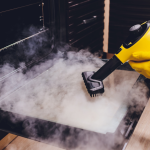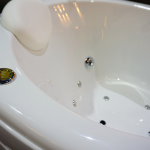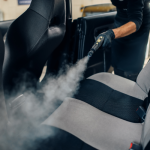Who wouldn’t want shiny ceramic or porcelain tiles in their home? A ceramic tile floor can give a unique character to an interior. However, if they are not properly and regularly maintained, the later cleaning process can be more difficult, significantly more time-consuming and exhausting.
Today we will present to you some of the most effective ways of cleaning ceramic tiles. Ceramic tiles are a popular choice for floors in the kitchen, bathroom or hallway. These tiles look stunning and are incredibly durable. Despite thorough cleaning, however, they sometimes become discoloured. So how can you ensure their flawless appearance?
Cleaning Ceramic and Porcelain Tiles
Thanks to a few simple cleaning techniques, ceramic and porcelain tiles can look flawless for a very long time. To clean ceramic and porcelain tiles, simply follow the below (simple) steps.
Remove dirt
Remove any loose dirt. To prevent your tile floor from becoming dull, sweep or vacuum it often. Although they are resistant to dirt, sand and particles can damage the glazed surfaces of ceramic tiles.
Choose the right mop
For cleaning tiles, use a mop with a cloth or a chamois mop – not a sponge mop – and clean water. Sponge mops tend to drive dirty water into grout lines, making them harder to clean. When mopping, make sure you constantly change the water, as dirty water causes a murky residue to be left on the floor.
Beware of stains
If you notice a stain, first try to identify the substance that caused it. For the best cleaning results, choose a cleaner suitable for the type of stain.
Check for soap/detergent residue
Even after washing, your tiles may look as if they’re foggy, due to soap residue. Use a non-abrasive, all-purpose cleaner to remove this film. On ceramic or porcelain tiles, you can also try a homemade cleaner with an acid additive, such as fresh lemon juice (but never do this on stone tiles).
Dry the floor
Do not allow water to remain on your glazed tile floor and air dry. This can cause water stains to form. After washing, make sure to quickly dry the floor with a clean, non-linting cloth.
How to clean resilient tile floors?
Resilient tiles, made from materials such as linoleum, vinyl, cork, and rubber, are a great choice if you expect a surface that is versatile and does not require special maintenance. When cleaning resilient tile floors, consider the following aspects:
Vinyl tile floors
This incredibly durable flooring option is also easy to maintain. Simply sweep or vacuum any dirt, then clean the floor with vinegar and water or a special vinyl cleaner. Never scrub vinyl with cleaning agents or equipment that can cause scratches.
Linoleum floors
Despite often being confused with vinyl flooring, linoleum is a completely different substance that requires special cleaning procedures. After sweeping or vacuuming, wash the linoleum tiles with water or a special cleaner for linoleum floors.
After thoroughly rinsing, dry the floor. Every three to six months, apply a layer of wax or liquid wax and polish to protect your linoleum floors.
Cork tile floors
Depending on how your tiles are finished, different cleaning procedures are required for cork tiles. If the cork surface is coated with polyurethane (most cork floors have this seal), clean the cork surface with water and mild soap or white vinegar, then rinse thoroughly. If the cork is unfinished or waxed, follow the cleaning recommendations for polyurethane, but after the tile has dried, apply solid or liquid wax.
How to clean tile grout?
Clean grout is key to a beautiful tile floor. Grout can be difficult to keep clean, as it is porous and absorbs stains, such as oil and other substances. Here’s how to restore the fresh look of grout.
Make your own grout cleaner at home by mixing baking soda with water to make a paste.
Apply it to the stain, leave it overnight, and scrub the stain the next day with a hard nylon brush or an old toothbrush (a metal brush will damage the grout). This process requires repetition.
Apply a silicone-based sealer to the grout to make it stain-resistant. It works best when applied 10–14 days after installation or grout replacement.
Steam Cleaning Floors
Over the past few years, steam cleaning has become the preferred method of cleaning and disinfecting various things, including all kinds of vehicles, homes, offices, medical facilities, and many different types of commercial businesses.
Steam cleaning is environmentally friendly as operators need little to no additional detergents or other agents to disinfect and refresh various surfaces. The biggest advantage of steam cleaning is the ability to kill and remove over 99% of bacteria, viruses, germs, and other pathogens. However, working with a large, diesel-powered steam cleaner is not practical for many different types of cleaning jobs. That’s why check out the new Fortador Volt MINI portable steam cleaner.
How to clean a tile floor using a Fortador steam cleaner?
Here are the step-by-step instructions on how to clean tile floors with a Fortador Volt Mini steam cleaner. Depending on the model of steam mop you’re using, instructions and steps may vary.
Sweep up loose dirt with a broom
Make sure the dirt does not stick to the floor! Collecting dust before wet cleaning is key to a flawless tile floor.
Check what type of tiles you have on the floor
There are many types of floor tiles, including ceramic, terracotta, cement, and natural stone.
Tiles made from porous natural stone, such as travertine, marble, and limestone, should be properly sealed to prevent staining.
Others don’t need sealers, as they’re resistant to moisture, e.g. ceramic and porcelain tiles. Terracotta tiles are a poor choice for a kitchen backsplash, as they can quickly become stained if they are unglazed. However, thanks to their grainy structure, they can easily hide occasional spills on the kitchen floor or in the utility room.
Once you know what type of tile you have, you’re ready to move on to the next step.
Choose a cleaner depending on the type of tiles
You should not clean cement tiles with anything acidic, including vinegar-based solutions. Instead, use “stone-safe” cleaners on marble, travertine, limestone, and other natural stone tiles. Also remember to avoid cleaners that contain bleach.
For specific advice on stain cleaning, check what the tile manufacturer recommends. Stains from spilled pasta sauce may require a different cleaning method and/or agent than, for example, stains from grease splatters.
For removing stains from typical food spills and settling dirt, warm water and a sponge work well. Warm water and a small amount of soap should be the next step after just using water and a sponge.
Turn on your steam cleaner
Plug your Volt Mini into an outlet. Press the button on the touchscreen to turn it on. You should hear a beep requesting water. If you want, you can attach the included spray bottle and add a cleaner to it. Wait for the steam cleaner to heat up.
Attach any of the stiff brushes to the steam nozzle and clean the grout between the tiles
The grout between the tiles can get dirty over time, so make sure you steam them one by one, wiping off excess dirt with a damp cloth.
After you finish cleaning the grout between the tiles, you can move on to cleaning the tiles.
Attach the steam mop
After cleaning the grout between the tiles, attach the steam mop to the steam nozzle. Put a clean microfiber cloth on the steam mop. It will absorb any remaining dirt from the floor.
Whether you have ceramic or porcelain tiles, start cleaning the floor as you would with a regular mop. If your steam mop comes with a spray bottle, the cleaner you’ve chosen (floor cleaner or homemade) will help further neutralize any unpleasant odors.
Dry the floor
If necessary, go over spots or grout lines again that weren’t sufficiently cleaned by the steamer. After completely cleaning the grout and tiles, wipe the floor with a clean cloth. To avoid unwanted stains, make sure the floor is completely dry before anyone walks on it.
Tile floor cleaning tips
- Keep it simple
Don’t let a lot of water accumulate on your tile floor. Water rarely penetrates tiles, but it can leave unsightly spots that require additional, tedious cleaning.
- Remember the grout
We often forget to clean the grout because we assume it has to be done at the same time as cleaning the tiles. This is not the case. So once a month, thoroughly clean the grout and seal it if necessary.
- Use a natural floor cleaner
On tiles, natural agents such as vinegar and baking soda work wonders. Both are suitable and safe for homes with pets or small children.
Avoid cleaners with an acidic pH. If you have marble or granite floors, avoid cleaning floors with white vinegar.
FAQ
What should I not use to clean tile floors?
Ensuring you know what type of tile you have on the floor is key when wet cleaning. You wouldn’t use an aluminum cleaner on a ceramic fridge. The same is true for tile floors. Sometimes the best cleaning solution may be a paste made from baking soda.
Why do my floor tiles always look dirty?
Your tiles may always seem dirty because you let dirty water dry on their surface and it left a deposit. Additionally, it’s possible that the detergent you’re using reacted with the tiles and stained the surface.
Is it safe to clean tile floors using a steam mop?
Yes! The steam mop attached to the Fortadora Volt Mini does not damage any surfaces. The extreme heat emitted by steam is just water particles in a gaseous phase that easily remove dirt.
How often should I clean tile floors?
We suggest a regular cleaning routine that includes both dry and wet cleaning to keep your tiles always looking clean and free from deposits.
Dry cleaning:
Sweep or vacuum at least once a week, or when visible trash is present. Any type of tile floor can be cleaned with a vacuum with a soft brush, but maneuvering it in corners or other hard-to-reach places can be difficult. To finish cleaning, use a broom.
Wet cleaning:
Plan on mopping the kitchen tile floor every two weeks, and the bathroom tile floor once a week. Also, take some time every few months – or when they start to look dirty – to clean the grout.




